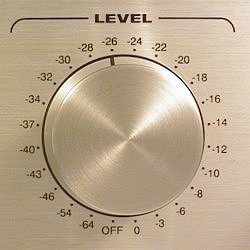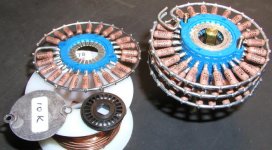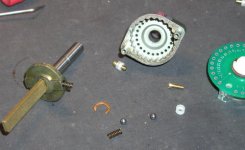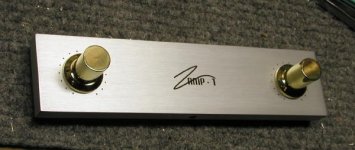Hi,
Got a feeling you're confusing the two....
Cheers,
With these ebay volume controls I have there's silence between clicks, so I presumed they're break before make.
Got a feeling you're confusing the two....
Cheers,
fdegrove said:Hi,
Got a feeling you're confusing the two....
Cheers,
how so?
Anybody looking at this picture can see that those are make before break switches.
As I said before, I have both of them in my hand and cannot say that Elma is that much better. It may be a matter of taste, but for me the spring loading on Elma is still too much and the clicks are louder. I also have an Electroswitch, and this is a totaly different cup of tea.
Regarding the Chineese switches. The ball and the spring mechanism is made in such a way that each step is not exactly the same; on turn is a bit louder and tighter than the next (every other to be precise), but this is nothing to be concerned about really
As I said before, I have both of them in my hand and cannot say that Elma is that much better. It may be a matter of taste, but for me the spring loading on Elma is still too much and the clicks are louder. I also have an Electroswitch, and this is a totaly different cup of tea.
Regarding the Chineese switches. The ball and the spring mechanism is made in such a way that each step is not exactly the same; on turn is a bit louder and tighter than the next (every other to be precise), but this is nothing to be concerned about really
Attachments
Hi,
One can't tell from pics, Peter.
There're no springs in my Elmas but what you feel is the ball bearing moving in the cage from one step to the other.
That's subjective of course...You'd better not shell out any money for the big Shallcros' or Blore Edwards' then....Those are really click, clock, ouch too far, loaded but are said to sound way better than the ordinary switches.
Be a Belgian, compromise...
Anybody looking at this picture can see that those are make before break switches.
One can't tell from pics, Peter.
It may be a matter of taste, but for me the spring loading on Elma is still too much and the clicks are louder.
There're no springs in my Elmas but what you feel is the ball bearing moving in the cage from one step to the other.
but for me the spring loading on Elma is still too much and the clicks are louder.
That's subjective of course...You'd better not shell out any money for the big Shallcros' or Blore Edwards' then....Those are really click, clock, ouch too far, loaded but are said to sound way better than the ordinary switches.
Be a Belgian, compromise...
fdegrove said:Hi,
One can't tell from pics, Peter.
There're no springs in my Elmas but what you feel is the ball bearing moving in the cage from one step to the other.
That's subjective of course...You'd better not shell out any money for the big Shallcros' or Blore Edwards' then....Those are really click, clock, ouch too far, loaded but are said to sound way better than the ordinary switches.
Be a Belgian, compromise...
What do you mean you can't tell from a picture? You see a wiper and contact blades. The spacing on blades is less than the size of a viper blade. What does it tell you?
The ball in Elmas is still pressed against spring mechanism and depending on the force of this spring the clicking and turning is stronger or lighter.
I didn't find a switch that I liked yet. How about that for Belgian compromise?
Hi,
LOL...
The blades I see...
Dammm... I may need a set of reading glasses after all..
Hmmm...Maybe I used a different one, never found any spring in it, a ball in cage bearing, yes.
They're working on a Shallma right now....
LOL...
What do you mean you can't tell from a picture? You see a wiper and contact blades
The blades I see...
Dammm... I may need a set of reading glasses after all..
The ball in Elmas is still pressed against spring mechanism and depending on the force of this spring the clicking and turning is stronger or lighter.
Hmmm...Maybe I used a different one, never found any spring in it, a ball in cage bearing, yes.
I didn't find a switch that I liked yet. How about that for Belgian compromise?
They're working on a Shallma right now....
fdegrove said:
Hmmm...Maybe I used a different one, never found any spring in it, a ball in cage bearing, yes.
You must be using an older model
Attachments
Hi,
Yep...No springs here...
I think mine are still in the Elma catalogue...they had a 6 in their ref, I think....
No wonder yours annoyed you.
Mine went click, click, click, like an ALPS pot with detents...No more no less.
I love them but admit to hating the counting left and right channels...The price you pay for dual mono.
Cheers and nice talking to you again, Peter,
You must be using an older model
Yep...No springs here...
I think mine are still in the Elma catalogue...they had a 6 in their ref, I think....
No wonder yours annoyed you.
Mine went click, click, click, like an ALPS pot with detents...No more no less.
I love them but admit to hating the counting left and right channels...The price you pay for dual mono.
Cheers and nice talking to you again, Peter,
fdegrove said:
I love them but admit to hating the counting left and right channels...The price you pay for dual mono.
There is a simple solution to that. Why not put dots around the knobs (every other position)? Setting both switches is much easier this way and you don't have to count it anymore (as I used to do).
If you don't want to go through the trouble of silkscreening or laser etching, a simple dry transfer method (like Letraset) will do the job
Attachments
Hi,
Sure...or use Vernier dials...
Thing is, the stepped attenuators replaced regular pots (ALPS) left and right.
Even when you have to count with those, you know you have to count the steps left and right.
As the knobs have a marker, you get used to it; you count and have a visual feedback from the marker.
In the dark it can get tricky....
Thanks for the tip, it sure will make it easier for sure.
Cheers,
There is a simple solution to that. Why not put dots around the knobs (every other position)? Setting both switches is much easier this way and you don't have to count it anymore (as I used to do).
Sure...or use Vernier dials...
Thing is, the stepped attenuators replaced regular pots (ALPS) left and right.
Even when you have to count with those, you know you have to count the steps left and right.
As the knobs have a marker, you get used to it; you count and have a visual feedback from the marker.
In the dark it can get tricky....
Thanks for the tip, it sure will make it easier for sure.
Cheers,
fdegrove said:Hi,
Because the ones that transit from one position to another quietly are the "make before break" types.
The other type causes an open circuit when switching, hence the breaking noises.
Cheers,
uh. as I said, there's silence between clicks. silence meaning no signal. therefore, I inferred that the switch probably opens between clicks. hence why I decided that it's of a `break before make` type. should I elaborate on that?
Peter Daniel said:Anybody looking at this picture can see that those are make before break switches.
I took mine apart and the contact surface is only that small pimple thing on the wiper, so it's possible that it might not contact adjacent positions in certain orientations. actually, now that I think of it, since the contacts are not plated, any amount of oxidation increases the chances of this happening greatly and that's probably what's I'm experiencing (I have the pleasure of witnessing this effect with my dmm's probes every day -- presence of a visual but not electrical contact).
fdegrove said:I love them but admit to hating the counting left and right channels...The price you pay for dual mono.

(photo was stolen from http://goldpt.com
Hi,
No idea what is you're trying to tell us but:
Don't know about the rest of the planet but I'd go for the "make before break" type for audio use.
More importantly you gave the impression that the cheapo Chinese built atts were of the "break before make" type, not something I want with a 1M input impedance on the grid of my tubes.
So which is is it?
Cheers,
No idea what is you're trying to tell us but:
I inferred that the switch probably opens between clicks. hence why I decided that it's of a `break before make` type. should I elaborate on that?
Don't know about the rest of the planet but I'd go for the "make before break" type for audio use.
More importantly you gave the impression that the cheapo Chinese built atts were of the "break before make" type, not something I want with a 1M input impedance on the grid of my tubes.
So which is is it?
Cheers,
heh. so tell me, what exactly confused you when I complained that the attenuators in question are of a `break before make` type (to peter: yes, yes, your points are takenfdegrove said:Don't know about the rest of the planet but I'd go for the "make before break" type for audio use.
Hi,
The part when Peter D. said that his weren't...
Having ordered from the same source, or so I think...
Cheers,
heh. so tell me, what exactly confused you when I complained that the attenuators in question are of a `break before make` type
The part when Peter D. said that his weren't...
Having ordered from the same source, or so I think...
Cheers,
If you want to buy a switch that represents the ultimate in quality, contact Tech Labs Inc. , 955 Belmont Ave. North Haledon, NJ tel 973-427--5333
there URL is www.techlabsinc.com BUT there is something wrong with the site right now and it doesn't come up right.
I bought a 4 deck, shorting, 23 position per deck military grade switch from them last year for $135 bucks. Its like Daven switch quality, or some old Shallcross military type stuff. Rated for (check this) 1 million rotational cycles. Coin silver contacts, quarter inch thick glass fiber dialectric for the decks, etc. Came with a unique little gizmo on the first deck that allows adjustment of rotational force on the click stops from [snick] [snick] to SNICK!!! SNICK!!!
Truly beautiful piece of workmanship. I hought a similar switch from them in 1983: same build quality. They've been in business for a long time.
I dealt with Earl M. Bjorndal, Vice President by e-mail. He indicated that they could build a stepped attenuator for me if I didn't care to do the soldering myself. Of course, as a DIYer, I declined. I now have 1 resistor soldered, and about 90 or so to go. I figure I'll be finished soldering in about 6 months.
I figure I'll be finished soldering in about 6 months.
Larry Wright
Seattle area
there URL is www.techlabsinc.com BUT there is something wrong with the site right now and it doesn't come up right.
I bought a 4 deck, shorting, 23 position per deck military grade switch from them last year for $135 bucks. Its like Daven switch quality, or some old Shallcross military type stuff. Rated for (check this) 1 million rotational cycles. Coin silver contacts, quarter inch thick glass fiber dialectric for the decks, etc. Came with a unique little gizmo on the first deck that allows adjustment of rotational force on the click stops from [snick] [snick] to SNICK!!! SNICK!!!
Truly beautiful piece of workmanship. I hought a similar switch from them in 1983: same build quality. They've been in business for a long time.
I dealt with Earl M. Bjorndal, Vice President by e-mail. He indicated that they could build a stepped attenuator for me if I didn't care to do the soldering myself. Of course, as a DIYer, I declined. I now have 1 resistor soldered, and about 90 or so to go.
 I figure I'll be finished soldering in about 6 months.
I figure I'll be finished soldering in about 6 months. Larry Wright
Seattle area
- Status
- This old topic is closed. If you want to reopen this topic, contact a moderator using the "Report Post" button.
- Home
- Design & Build
- Parts
- Found: source for cheap ladder attenuators


